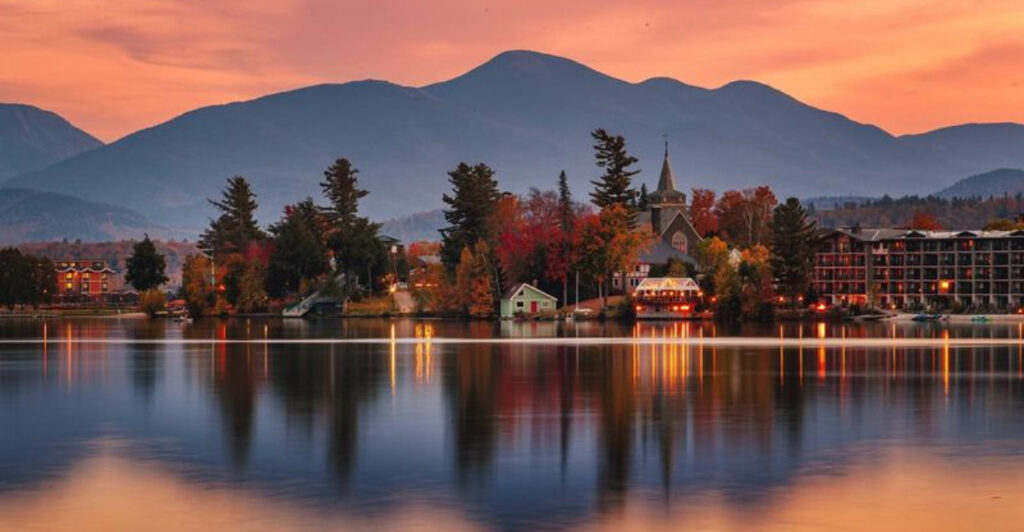From the rugged Rockies to the misty Appalachians, America’s mountain towns offer front-row seats to nature’s most spectacular shows. These hidden gems combine small-town charm with jaw-dropping panoramas that change with the seasons. Whether you’re seeking snow-capped peaks, golden aspen groves, or rolling blue ridges disappearing into the horizon, these 15 mountain towns deliver views that will leave you speechless.
1. Telluride, Colorado: A Box Canyon Paradise
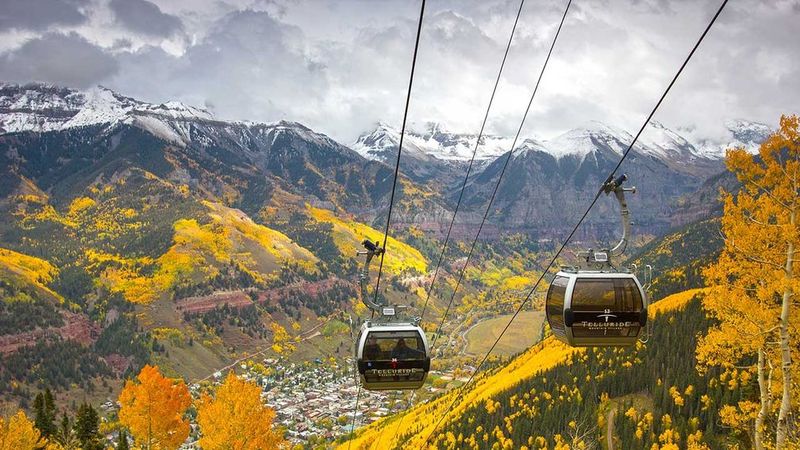
Surrounded by 13,000-foot peaks that seem to touch the sky, Telluride sits perfectly framed in its box canyon setting. Victorian-era buildings line the streets, creating a charming contrast against the dramatic mountain backdrop. The free gondola ride offers a bird’s-eye view that’ll make your heart skip a beat.
Summer brings wildflower meadows that carpet the slopes in technicolor splendor. Fall transforms the mountains into a golden tapestry as aspen leaves quiver in the breeze. Even in winter, when snow blankets the town, Telluride maintains its storybook quality.
Bridal Veil Falls—Colorado’s tallest free-falling waterfall—cascades 365 feet down the canyon’s eastern end, adding another layer of natural drama. With no billboards or chain stores to interrupt the view, Telluride offers a pure, unfiltered connection to the San Juan Mountains that’s increasingly rare in today’s world.
2. Jackson, Wyoming: Where Tetons Meet the Sky

Nothing prepares you for your first glimpse of the Tetons rising abruptly from the valley floor without foothills—a geological marvel that creates one of America’s most distinctive mountain silhouettes. The jagged peaks, often snowcapped even in summer, stand sentinel over this former cowboy outpost, now a perfect blend of Western heritage and outdoor adventure.
Elk Refuge Road offers perhaps the most accessible panorama, with the full Teton range stretched before you like a painted backdrop. Morning light bathes the mountains in alpenglow, turning their granite faces pink and gold. As seasons shift, the scenery transforms—spring brings wildflowers, summer offers crystal-clear reflections in Jenny Lake, and fall paints the aspens in brilliant yellow.
Unlike many mountain towns, Jackson’s valley setting means you can see the entire range at once, creating a sense of scale that’s both humbling and exhilarating. Wildlife completes the picture, with moose, elk, and bison roaming freely across this mountain paradise.
3. Lake Placid, New York: Adirondack Majesty
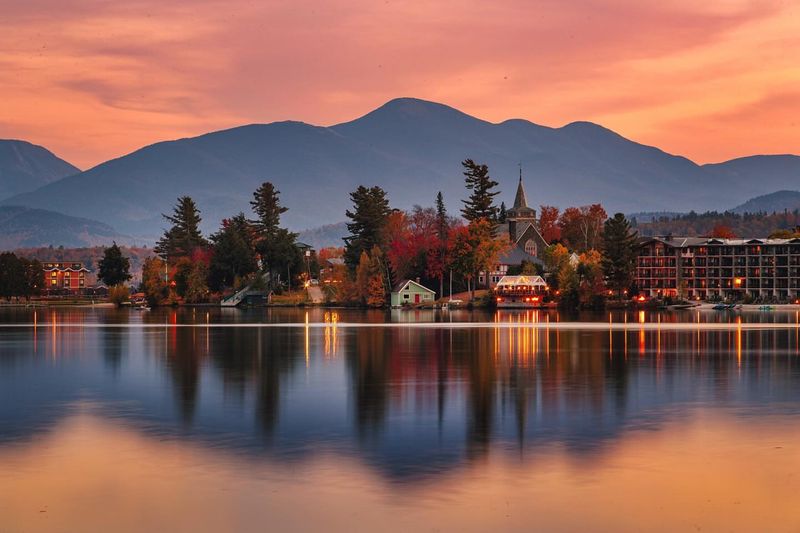
Mirror Lake lives up to its name, perfectly reflecting the surrounding Adirondack High Peaks in its glassy surface. The village perches between water and mountains, creating a double visual treat. Olympic history adds another layer of interest to this mountain gem, with the ski jumps standing as architectural exclamation points against the natural landscape.
Whiteface Mountain looms large in the distance, especially striking when dusted with early snow while autumn colors still cling to lower elevations. The view from Main Street combines small-town charm with wilderness grandeur, as shops and restaurants line the waterfront with mountains framing every vista.
Unlike the Rockies’ dramatic peaks, the Adirondacks offer a more ancient, rounded beauty—mountains worn by time into gentle giants. The 46 High Peaks create a rolling horizon in every direction. During winter, frozen lakes and snow-laden evergreens transform Lake Placid into a scene worthy of a snow globe, while summer brings lush green forests climbing every slope.
4. Gatlinburg, Tennessee: Gateway to Smoky Wonders
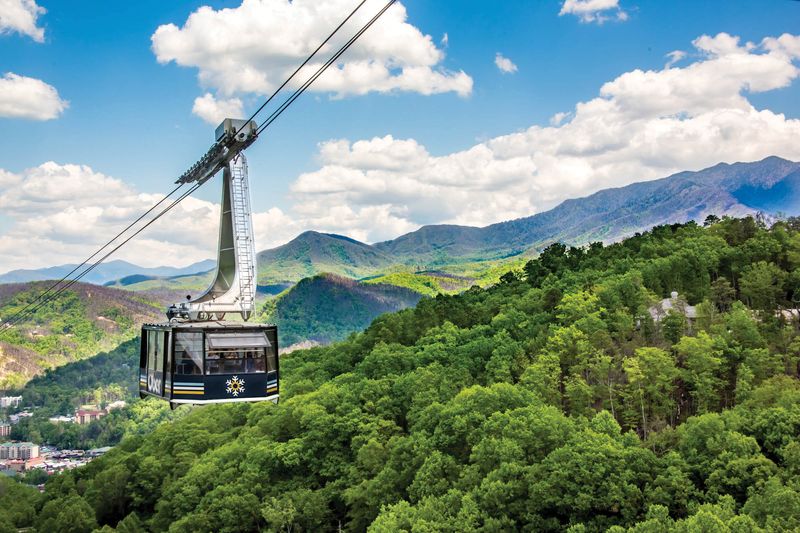
Morning fog drifts through the valleys, giving the Great Smoky Mountains their name and Gatlinburg its mystical atmosphere. The town sits at the entrance to America’s most visited national park, with mountain ridges rolling away in waves of blue-gray haze. From downtown, the Space Needle observation tower provides 360-degree views of the surrounding wilderness.
The SkyLift Park’s suspension bridge stretches 680 feet across a deep valley, offering heart-stopping views and a glass floor section for the truly brave. In autumn, the mountains explode with color as maples, oaks, and tulip poplars put on their seasonal show. The contrast between the developed valley and the pristine wilderness just beyond creates a unique viewing experience.
While some mountain towns require hiking for the best views, Gatlinburg makes spectacular vistas accessible to everyone. Ober Mountain aerial tramway glides visitors up 2,800 feet for panoramas that stretch across state lines. When evening falls, lights from the town twinkle against the dark mountain backdrop, creating a fairy-tale setting.
5. Leavenworth, Washington: Bavarian Alps in America
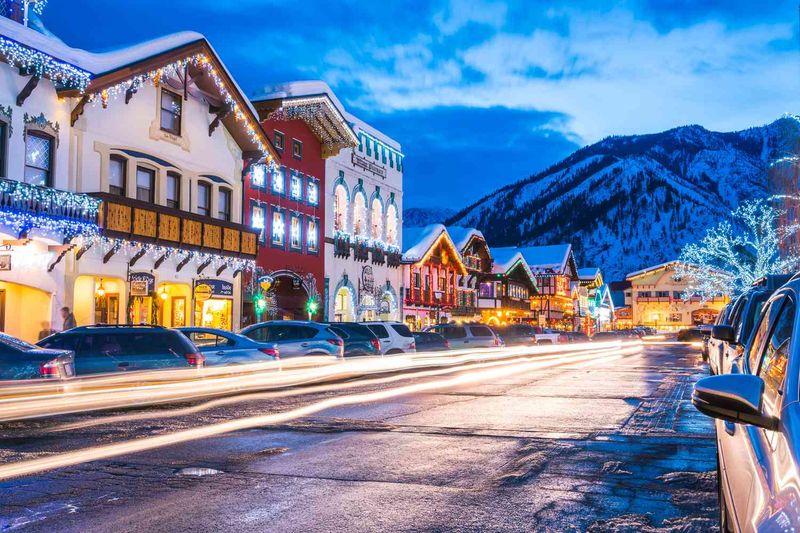
Snowcapped peaks of the Cascade Range create a dramatic backdrop for this Bavarian-themed village. The architectural transformation—complete with timber-framed buildings, flower boxes, and Alpine details—wasn’t just aesthetic whimsy but a brilliant reimagining that perfectly complements the mountain setting. The Wenatchee River curves around downtown, adding sparkling water to the mountain vista.
Blackbird Island offers easy walking trails with river and mountain views that change with each bend in the path. During spring, blooming orchards dot the valley with white and pink blossoms against the still-snowy mountains. Summer brings vibrant green forests climbing the slopes, while fall paints the hills with golden larches.
Icicle Ridge rises directly behind town, creating a protective wall of stone that catches the last rays of sunset. Winter transforms Leavenworth into a genuine wonderland, with snow-laden rooftops and mountain slopes aglow with thousands of twinkling lights during the Christmas season. The town looks so natural in its setting that visitors often forget its European appearance is entirely by design.
6. Aspen, Colorado: Playground of the Elk Mountains
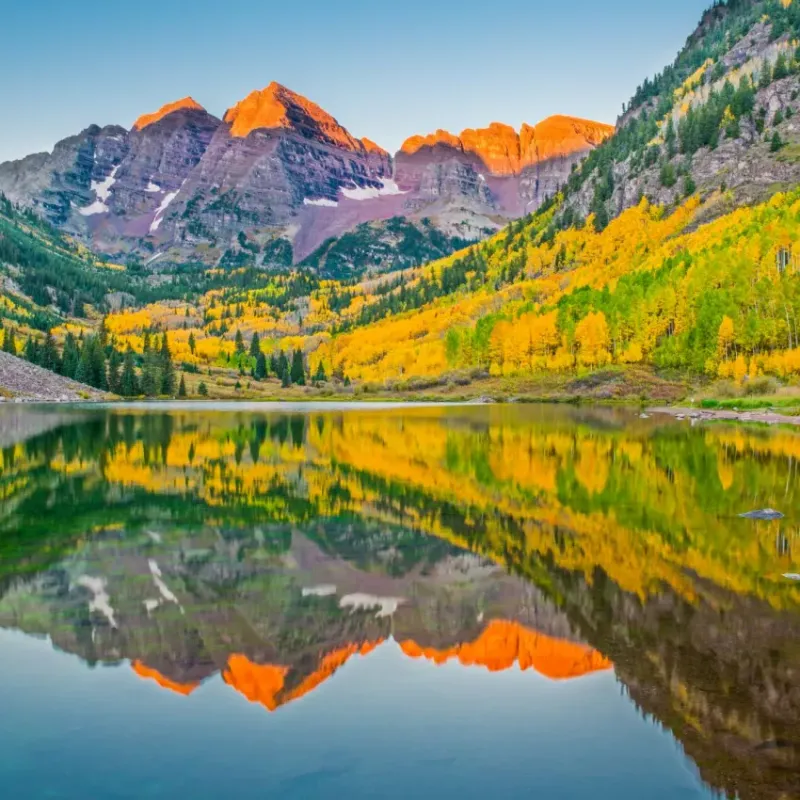
Few mountain towns combine natural splendor with cultural sophistication like Aspen. The famed Maroon Bells—perhaps the most photographed mountains in North America—reflect perfectly in Maroon Lake just outside town. Their distinctive burgundy color comes from the oxidized iron in the sedimentary rock, creating a unique palette against the Colorado blue sky.
Downtown streets offer uninterrupted views of Aspen Mountain (locally called Ajax), which rises dramatically from the edge of town. No gradual transition here—the mountain simply begins where the buildings end. The Silver Queen Gondola whisks visitors up 3,267 vertical feet to panoramic views that stretch across the Roaring Fork Valley.
Castle Creek Valley, just minutes from downtown, offers a different perspective with its narrow canyon and tumbling stream. Independence Pass, the highest paved crossing of the Continental Divide in the U.S., provides eagle’s-eye views of three mountain ranges. When fall arrives, the town’s namesake aspen trees transform into shimmering gold coins that seem to glow from within against the dark evergreen backdrop.
7. Stowe, Vermont: Green Mountain Grandeur
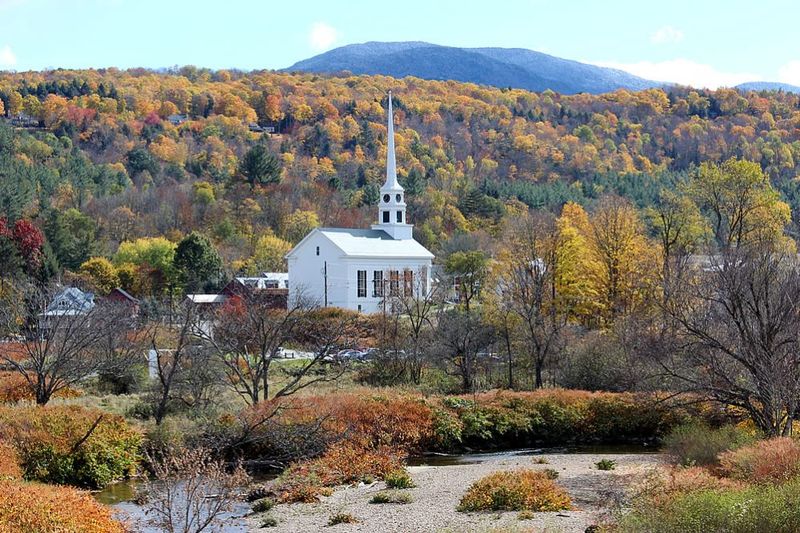
Mount Mansfield—Vermont’s highest peak—dominates the landscape around Stowe, its distinctive profile resembling a human face in repose. The Auto Toll Road winds up the mountainside, delivering visitors to views that stretch across three states and into Canada on clear days. Unlike the jagged peaks of western mountains, Stowe’s landscape offers a gentler beauty shaped by ancient glaciers.
The historic village with its white-steepled church creates a quintessential New England scene against the mountain backdrop. Covered bridges span bubbling streams, adding romantic touches to the already picturesque setting. The gondola at Stowe Mountain Resort provides year-round access to alpine vistas without the effort of hiking.
While Stowe shines in every season, autumn transforms it into a photographer’s dream. The famous Vermont fall foliage turns the mountainsides into a patchwork quilt of crimson, orange, and gold. Winter brings its own magic, with snow-draped evergreens creating a stark contrast against Mansfield’s white slopes. The Mountain Road offers pull-offs where you can safely stop and soak in views that have inspired artists for generations.
8. Mammoth Lakes, California: Eastern Sierra Splendor
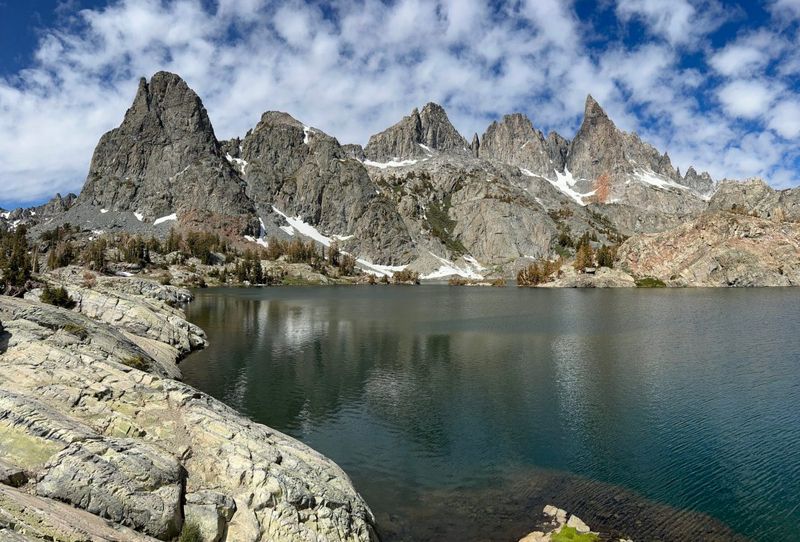
Volcanic origins give Mammoth Lakes a landscape unlike any other mountain town. The Minarets—a sawtooth ridge of spires and pinnacles—create a jagged horizon that seems torn from a fantasy novel. Sitting at 7,880 feet elevation, the town enjoys thin, crystal-clear air that makes distant peaks appear deceptively close.
The Lakes Basin contains a necklace of alpine jewels—Crystal, Barrett, TJ, and Mary Lakes among them—each reflecting the surrounding mountains in waters so clear you can count the rocks on the bottom. Convict Lake might be the most dramatic, with Mount Morrison rising almost vertically from its shores. Hot Creek offers the surreal sight of steaming geothermal waters winding through snow-covered meadows in winter.
Minaret Vista provides perhaps the most spectacular panorama, with the entire San Joaquin River Valley spread below and the sawtooth Minarets piercing the sky. Unlike many Sierra towns that sit in deep valleys, Mammoth’s position on a high plateau means expansive, unobstructed views in all directions. The ancient bristlecone pines that dot the landscape add gnarled, sculptural elements to an already dramatic scene.
9. Taos, New Mexico: Desert Meets Mountain Magic
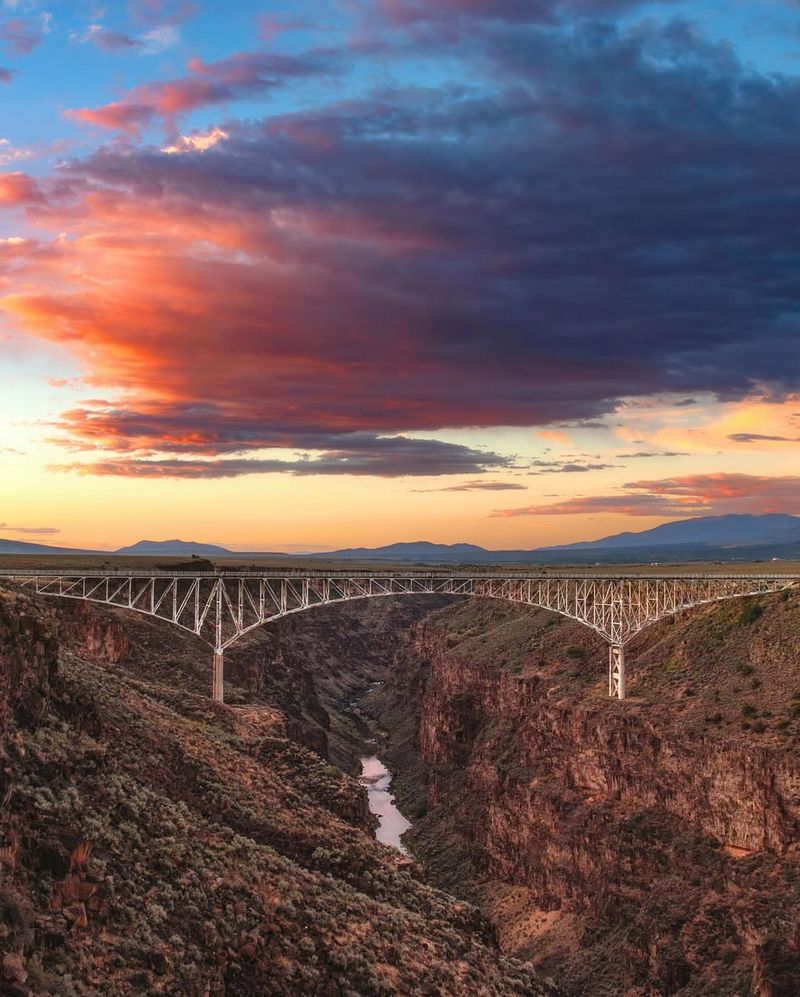
Nowhere else do desert and alpine landscapes merge so dramatically as in Taos. The town plaza sits at the base of the Sangre de Cristo Mountains, which rise abruptly from the high desert plateau. Their name—”Blood of Christ”—comes from the reddish glow they take on at sunset, creating a daily light show that stops traffic.
The Rio Grande Gorge cuts a deep slash through the landscape just west of town, with its bridge offering vertigo-inducing views 650 feet down to the river below. Wheeler Peak, New Mexico’s highest mountain at 13,161 feet, towers over the town with its distinctive rounded summit often wearing a cap of snow even in summer. Adobe buildings in the foreground create a perfect color complement to the blue-gray mountains.
Unlike the heavily forested mountains of the Pacific Northwest or the lush Appalachians, Taos’s mountains rise from arid terrain, creating stark contrasts between the sage-dotted desert and alpine zones above. The “enchanted circle” scenic byway loops around Wheeler Peak, offering changing perspectives of the mountain against skies that seem impossibly blue in the high desert light.
10. Bar Harbor, Maine: Where Mountains Meet the Sea
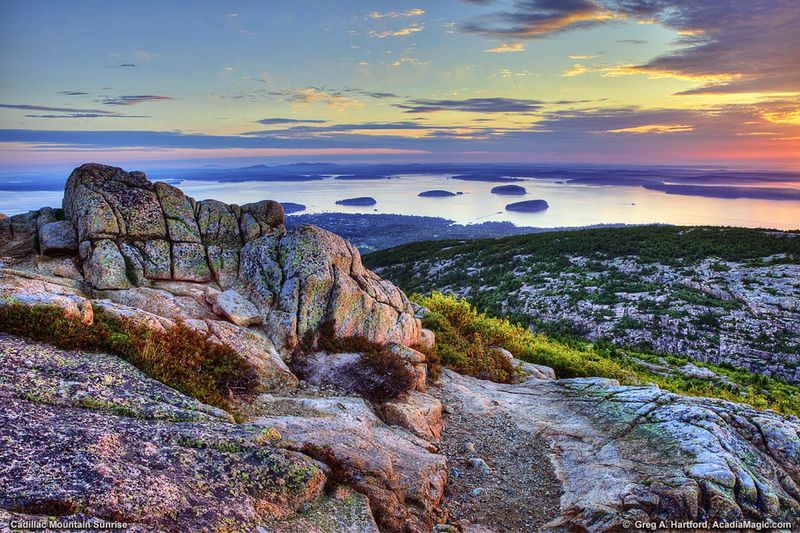
Few American landscapes offer the rare combination of granite mountains plunging directly into the Atlantic Ocean. Bar Harbor sits on Mount Desert Island, where Cadillac Mountain—the East Coast’s highest point—provides views of sunrise before anywhere else in the United States. The town itself curves around Frenchman Bay, with fishing boats and island-dotted waters in the foreground and mountains as the backdrop.
Ocean Path follows the eastern shoreline, offering constant views of waves crashing against pink granite cliffs. Thunder Hole channels incoming tide into a narrow inlet, creating explosive splashes and booming sounds that add auditory drama to the visual spectacle. The Porcupine Islands dot the harbor like stepping stones, their forested humps continuing the mountain theme into the water.
Unlike western mountain towns surrounded by ranges in all directions, Bar Harbor’s mountains have the Atlantic as their eastern boundary, creating a unique half-land, half-sea panorama. The summit of Cadillac Mountain offers a 360-degree view encompassing mountains, forests, lakes, islands, and the vast ocean horizon. When fall arrives, the mountains become a mosaic of red, orange, and gold against the deep blue sea.
11. Estes Park, Colorado: Rocky Mountain Majesty
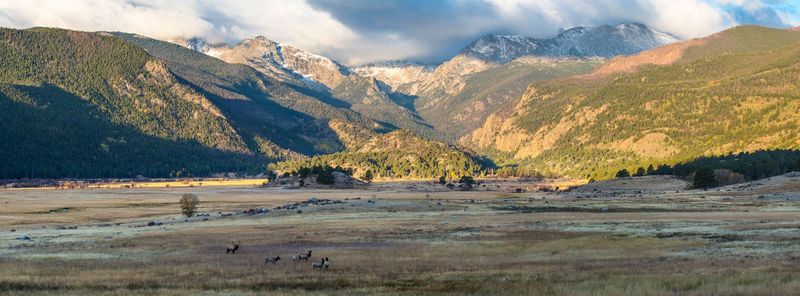
Longs Peak—a flat-topped giant reaching 14,259 feet—dominates the skyline of this gateway town to Rocky Mountain National Park. Elk graze casually in downtown meadows, seemingly posing against the mountain backdrop. The Stanley Hotel stands as a grand white landmark against the rugged terrain, its historic façade framed by peaks in every direction.
Lake Estes mirrors the surrounding mountains, with Trail Ridge Road—the highest continuous paved road in the United States—climbing to alpine heights where trees give way to tundra. During summer, wildflower meadows create carpets of color beneath the rocky summits. The distinctive notch of Mummy Range creates a perfect frame for spectacular sunsets.
Unlike deeper mountain valleys that limit long-distance views, Estes Park sits in an open bowl surrounded by peaks, creating amphitheater-like vistas in all directions. Gem Lake Trail offers perhaps the most accessible panorama, with relatively easy hiking leading to views of the entire valley. Winter brings its own magic when snow outlines every ridge and crevice of the mountains, creating a monochromatic study in light and shadow against Colorado’s famous blue skies.
12. Whitefish, Montana: Gateway to Glacier’s Grandeur
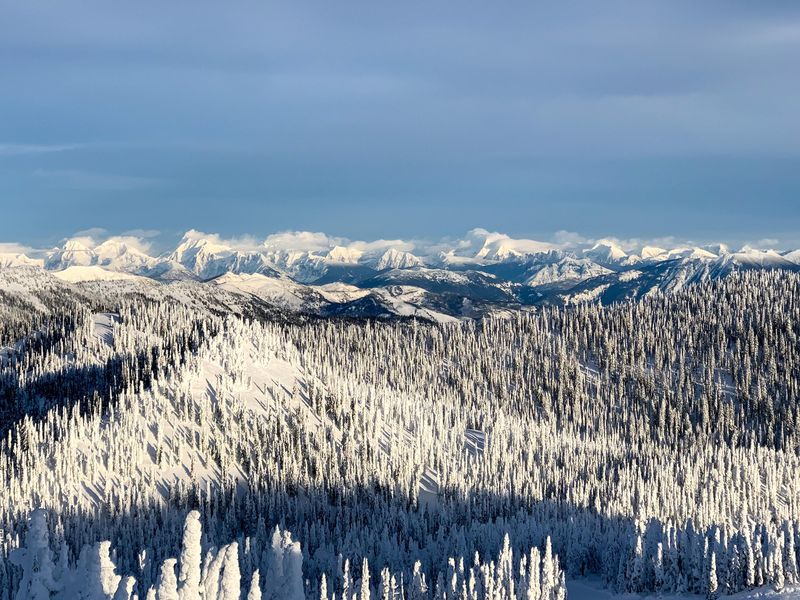
Big Mountain (officially Whitefish Mountain Resort) rises directly from the edge of town, providing a front-row seat to alpenglow on its slopes each evening. The pristine waters of Whitefish Lake stretch for seven miles, reflecting both the mountain and the changing sky. Unlike the more developed resort towns of Colorado, Whitefish maintains a genuine working-town feel while still offering world-class mountain scenery.
Just 25 miles away, Glacier National Park presents some of the most dramatic mountain terrain in North America. The jagged peaks were carved by massive ice sheets, creating horn-shaped summits and U-shaped valleys that define the landscape. From Danny On Trail on Big Mountain, hikers can see all the way to the Canadian border on clear days.
The views change dramatically with the seasons—summer brings wildflower meadows and green forests climbing the slopes, while fall paints the mountainsides with the golden glow of western larch trees (one of few conifers that change color). Winter transforms Whitefish into a snow globe scene, with powder-covered peaks standing stark against Montana’s famous big sky. The lack of crowds means unobstructed vistas and a sense of having the mountains all to yourself.
13. Asheville, North Carolina: Blue Ridge Panoramas
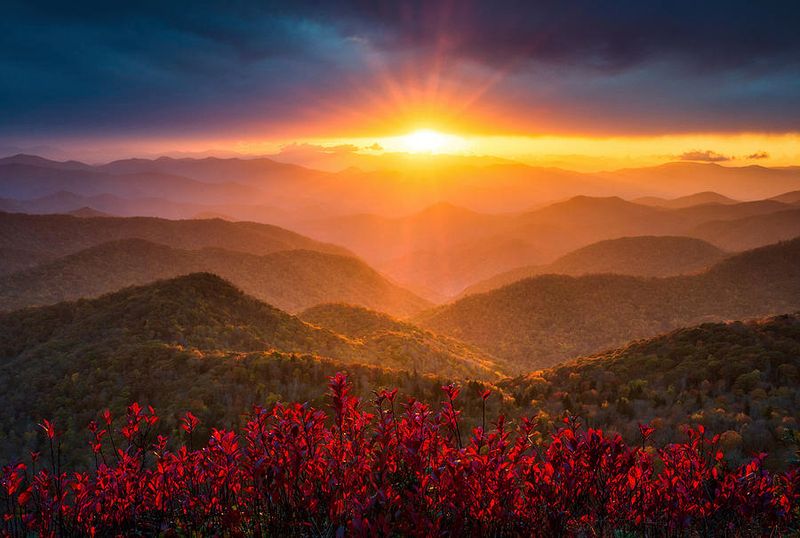
Layer upon layer of mountains fade into the distance in varying shades of blue—a phenomenon caused by the natural release of isoprene from trees. This distinctive blue haze gives the Blue Ridge Mountains their name and Asheville its dreamy vistas. Unlike the singular peaks that dominate western mountain towns, Asheville offers rolling waves of mountains in every direction.
The Biltmore Estate provides one of the most unique mountain views, with America’s largest private home framed by the Blue Ridge. Downtown rooftop bars offer urban foregrounds to natural backdrops, creating perfect sunset-watching spots. The Blue Ridge Parkway—America’s favorite scenic drive—winds along mountain crests, with overlooks providing safe places to stop and soak in panoramas.
Craggy Gardens explodes with native rhododendron blooms in June, adding vibrant pink to the blue-green landscape. Max Patch, a grassy bald along the Appalachian Trail, offers 360-degree views that feel like standing on top of the world. Fall brings Asheville’s most spectacular season, as the ancient hardwood forests erupt in a kaleidoscope of color that flows like rivers down mountain slopes and through valleys.
14. Park City, Utah: Olympic-Caliber Vistas
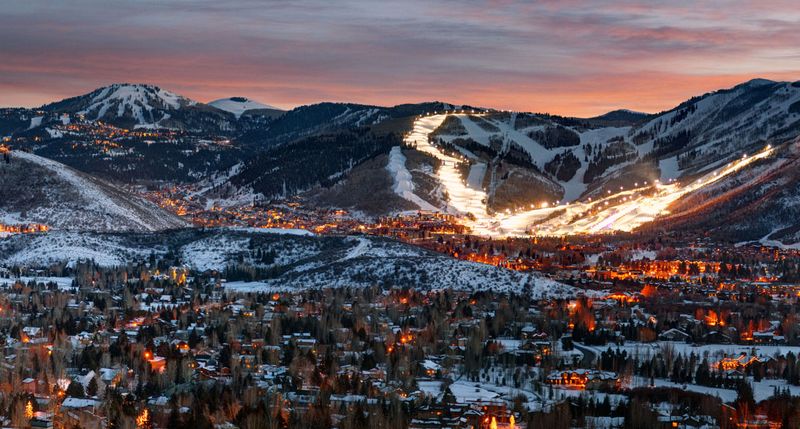
Three world-class ski resorts surround this former silver mining town, creating a crown of peaks that catch golden light at sunset. Unlike the jagged summits of the Tetons or the volcanic cones of the Cascades, the Wasatch Range offers a perfect balance of dramatic heights and accessible beauty. Main Street runs perpendicular to the mountains, framing perfect views at the end of every cross street.
The Olympic Park, built for the 2002 Winter Games, sits against a mountain backdrop that makes it clear why this area was chosen for elite winter sports. During summer, wildflowers carpet the ski slopes in yellows, purples, and reds. The surrounding Uinta-Wasatch-Cache National Forest creates a green boundary in every direction.
Guardsman Pass offers perhaps the most spectacular driving view, with hairpin turns revealing new perspectives around every corner. Unlike more isolated mountain towns, Park City sits just 30 minutes from Salt Lake City yet feels worlds away. The mountains here receive some of the lightest, driest powder snow in the world, creating a winter wonderland that transforms familiar landscapes into something magical. In fall, groves of quaking aspen turn brilliant gold against the evergreen backdrop.
15. Hood River, Oregon: Columbia Gorge Grandeur
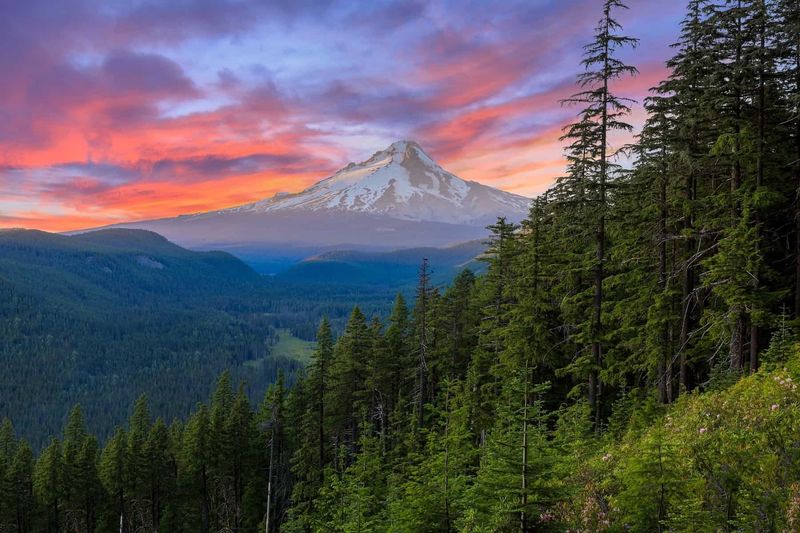
Mount Hood—Oregon’s tallest peak at 11,249 feet—dominates the southern skyline with its perfect volcanic cone often capped with snow year-round. The Columbia River Gorge stretches east and west, creating North America’s only sea-level passage through the Cascade Mountains. This unique geography gives Hood River a dual landscape few other mountain towns can match.
Orchards and vineyards climb the surrounding hillsides, adding geometric patterns to the natural landscape. Windsurfers and kiteboarders on the Columbia River provide colorful foreground elements against the mountain backdrop. The Historic Columbia River Highway offers vintage-styled stone viewpoints perched dramatically above the gorge.
Unlike many mountain towns nestled in valleys with limited views, Hood River’s position at the intersection of river and mountain provides expansive vistas in multiple directions. Panorama Point lives up to its name with views of Mount Hood, Mount Adams, and the fertile Hood River Valley. Waterfall season brings another dimension to the scenery, with cascades like Multnomah Falls plunging dramatically from cliff faces. The contrast between the wide, powerful Columbia River and the soaring volcanic peaks creates a landscape of beautiful opposites.

